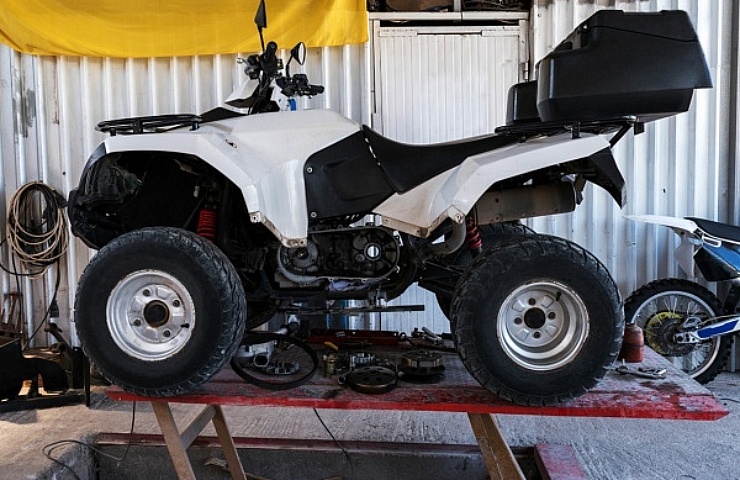Dominate the Wilderness: Your Ultimate ATV Exploration Awaits
Dominate the Wilderness: Your Ultimate ATV Exploration Awaits
Blog Article
ATV Riding Techniques: Grasping the Art of Off-Roading

Body Positioning
To efficiently navigate with tough off-road terrain, it is crucial for ATV cyclists to regularly keep appropriate body placing. Preserving the proper body setting while riding an ATV not only improves control and security yet also makes certain the motorcyclist's security. By adopting the correct body placing methods, cyclists can effectively distribute their weight, boost their equilibrium, and minimize the risk of accidents or injuries.
Positioning the feet on the foot secures allows the biker to preserve security and control over the ATV. The cyclist's knees ought to be slightly bent, providing a mild suspension to take in shocks and preserve equilibrium.
Additionally, the rider's eyes ought to constantly be focused in advance, checking the surface and anticipating any type of barriers or adjustments in the path. By keeping an onward gaze, riders can make instant decisions and react appropriately to challenging terrain.
Throttle Control
Structure upon the relevance of proper body positioning for ATV bikers, understanding throttle control is an important skill that makes it possible for motorcyclists to efficiently steer with numerous off-road terrains. Strangle control refers to the capability to control the amount of power delivered to the ATV's engine. By comprehending just how to adjust the throttle, bikers can ensure a smooth and controlled acceleration, allowing them to browse obstacles with accuracy.
One of the fundamental elements of throttle control is finding out to regulate the throttle smoothly. Unexpected or jerky activities can cause the ATV to shed traction or come to be unstable, making it difficult to maintain control. Rather, bikers should intend for deliberate and steady throttle inputs, specifically when passing through tough surfaces. This method enables the ATV to maintain a steady rate and supplies much better grip, decreasing the threat of accidents.
Along with smooth inflection, motorcyclists must likewise discover how to balance the throttle with other riding methods, such as body positioning and stopping. When climbing up high hills, riders need to use enough throttle to preserve momentum without subduing the ATV or triggering wheel spin. When coming down high inclines, cyclists should utilize the throttle in mix with appropriate body braking and positioning to keep control and stop the ATV from sliding or tipping over.

Braking Techniques
A crucial facet of ATV riding strategies is understanding efficient stopping techniques. It is essential to remember that severe braking with just the front brake can create the ATV to pitch ahead, possibly leading to loss of control or even flipping over. By understanding these braking strategies, you can enhance your ATV riding abilities and make certain a delightful and risk-free off-roading experience.
Cornering Strategies
One important facet of mastering ATV riding methods is understanding reliable cornering strategies. Cornering on an ATV can be challenging, however with the best strategies, motorcyclists can navigate turns safely and successfully. The key to successful cornering is a fantastic read to preserve control of the ATV while optimizing traction and decreasing the risk of toppling.
To implement a proper cornering technique, cyclists must approach the turn at an appropriate speed, guaranteeing they are not going as well slow-moving or too rapid. It is important to move the body weight in the direction of the within the turn, leaning into it to maintain equilibrium and stability. This helps for the centrifugal force and maintains the ATV upright.
Furthermore, bikers need to maintain their eyes focused on the leave factor of the turn instead of the instant course ahead (ATV). This enables for smoother and extra exact guiding, as it assists the rider prepare for any obstacles or adjustments in surface
Furthermore, proper throttle control plays a significant duty in cornering. Motorcyclists have to regulate the throttle smoothly, avoiding sudden accelerations or slowdowns, which can cause loss of control.
Uphill and Downhill Riding
When browsing off-road terrain, ATV motorcyclists need to grasp the techniques for uphill and downhill riding to keep control and make certain safety and security. Uphill riding needs a mix of equilibrium, throttle control, and weight distribution. As motorcyclists rose high slopes, they need to lean see this page ahead to shift their weight towards the front of the ATV, which boosts traction on the front wheels and avoids the car from turning backwards. ATV. Furthermore, maintaining a consistent throttle and preventing sudden velocity or slowdown aids to avoid the ATV from shedding energy or getting stuck. Downhill riding, on the other hand, calls for motorcyclists to lean back and change their weight towards the rear of the ATV. This assists to maintain stability and protect against the car from flipping forward. It is vital to utilize the brakes sparingly and use them progressively to avoid securing the wheels and blowing up. Bikers should choose the path with the least challenges, as browsing downhill can be much more tough due to the enhanced speed and lowered grip. By understanding the strategies for uphill and downhill riding, ATV riders can confidently deal with various off-road surfaces and enjoy a risk-free and electrifying journey.
Conclusion
In conclusion, grasping the art of ATV riding requires a mix of body positioning, throttle control, stopping strategies, and reliable cornering. Uphill and downhill riding additionally require certain abilities to navigate securely. By carrying out these strategies, cyclists can improve their off-roading experience and enhance their overall control and security on the ATV.
ATV Riding Techniques: Mastering the Art of Off-Roading is a thorough guide that digs into the ins and outs of mastering the skills required for off-road ATV riding. Whether you are a beginner or a seasoned motorcyclist, ATV Riding Techniques: Understanding the Art of Off-Roading provides indispensable guidance to help elevate your off-road ATV riding abilities to the next level.

Report this page